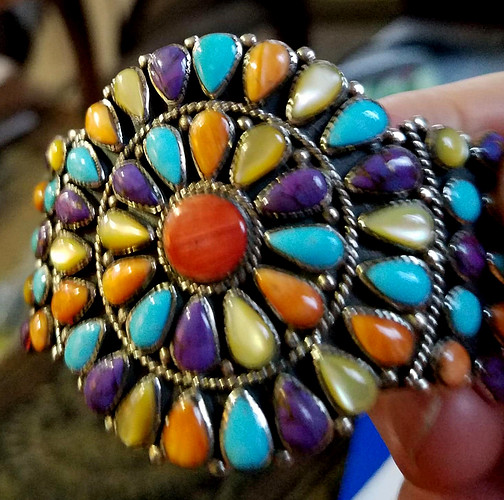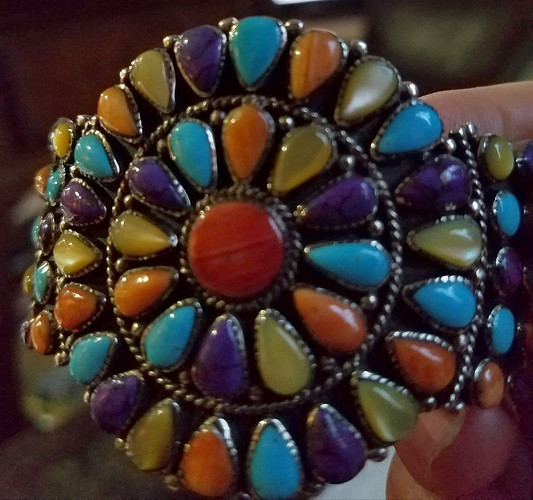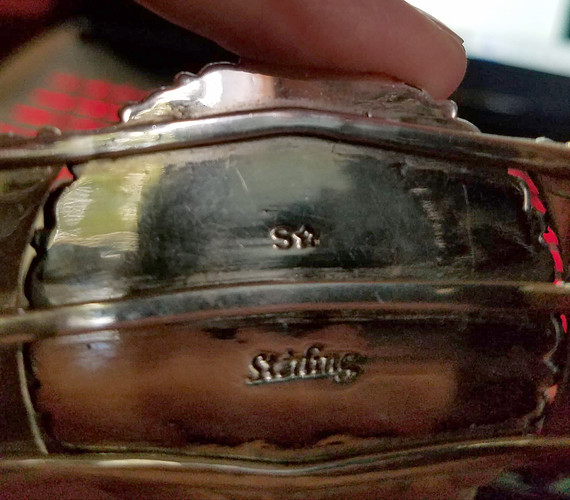I uploaded 3 images, but they’re showing up as text. I hope they show up. This is a multi-colored Zuni-style bracelet, with turquoise, 3 colors of spiny oyster and gold-colored mother of pearl. The hallmark is *S (star S). It is also marked as Sterling. Thanks for any help!
My initial thought is the bracelet is manufactured and not Native American made. What can you tell us about it?
Unfortunately this is a Philippine made piece. Ask me how I know.
https://forum.turquoisepeople.com/t/is-this-ithaca-peak-turquoise/2511/7
Yes, please, tell me how you know. I want to learn.
Well, MarkyBoy57 has just given me a good education. I still like it (I am an old hippie-girl, after all), and I think I probably paid a fair price for it at $100. Update: @markyboy57, with your help, I found the same exact bracelet on eBay for $180, so I guess I’m not unhappy. I enjoy wearing it and I got it at a discount, and now I know that hallmark, I’ll never make that particular mistake again. What’s not to like?
@markyboy57 and @Jason I’ve been perusing the Silver Expressions offerings on eBay, and I’m becoming confused and curious. Most of their pieces appear to be made in the Philippines, but some of them are marked Navajo-made, and signed by the artist. Most–but not all of those do not have the S Star hallmark. To make things even more confusing, some of the pieces are handcrafted (they say) in the southwest of the USA (presumably by native artists???), but bearing the S Star hallmark. My questions–is this somewhat unethical, or at least misleading? And are the Navajo jewelers likely to be paid a fair price for their work? Silver Expressions prices appear to be somewhat lower than comparable pieces which are native made and sold. As a purchaser, is it best to avoid these types of businesses altogether? Inquiring minds want to know.
I’m not searching out that seller to check the goods, but to answer generally: It’s illegal to market goods as Navajo or any other Native community if they’re not, so it goes beyond being unethical. Know your seller as best you can, if you can’t quite tell enough about the material, in order to avoid participating in consumer fraud. That can mean checking into reputation via online searching, and asking questions directly, and ultimately developing your own connoisseurship as best you can.
Came here to reiterate what Chicfarmer said above - it is ILLEGAL, but that doesn’t stop (or even slow down) some online sellers, esp on auction and other sites with a lot of jewelry. Even an ill-informed seller with good intentions can commit fraud. Best advice is educate yourself, be skeptical when buying online, and if you’re buying 2nd hand (as opposed to directly from the maker) remember that the Native American artist gets zero from your purchase. If you want to do more to support native americans, buy art directly from the artists. Forgers and fraudsters and importers get better every day at mimicry, and we all get fooled now and then. Don’t beat yourself up, but don’t pay Native American-made prices for import fakes.
As everyone else has said, you must be very careful when purchasing online and even in person. I remember bidding on that Naja, on my cell phone, while riding with my son to a family Christmas party. It was described as Sterling silver and from what I could see from the pictures on my phone, really nice looking turquoise. In reality it turned out to be nickel silver with "Mojave turquoise " a compressed cheap imitation of good turquoise. So I paid $280 for something worth about $30. It was stupid to bid on something that I was unsure of. The only upside is that my wife likes it and wears it quite often, as she doesn’t have to worry about damaging an expensive piece of jewelry.
There are many unscrupulous dealers marketing fakes, especially “signed” pieces as these increase their profits. Now there are also dealers that sell knock offs that are not misrepresenting what they are. I bought a multi stone inlay squash blossom necklace that my wife liked because it matched much of what she wears. But, we knew what we were buying and the dwaler was not misrepresenting what it was, also it only cost $70. Here is a picture
There are TONS of imported, Native American style fakes on ebay and elsewhere. They range from blatantly mislabeled as handcrafted Native American when they are in fact machine made imports, to carefully described so as not to break the law but in a way that a casual buyer may not understand the difference (Native American STYLE, ect), to clearly labeled for what they are (Faux turquoise Philippine made…). All of these things undercut the market and hurt Native American artists, even if the prior is clearly more offensive and as others have stated illegal. And genuine Native American art can be obtained at all different price points, including very affordably.
Here is a great article from National Geographic a couple of years ago that goes into a lot of depth on the topic:
https://www.nationalgeographic.com/news/2018/03/native-american-indian-art-fake-forgery-hopi-zuni0/
You’re right. That’s a good article. Also, I’ve been reading the book Turquoise and the Indian by Edna Mae Bennett. She does a good job of describing the effect the coming of the railroads and the Fred Harvey company had on both boosting interest in native-made items, but also perpetrating first “short cuts”, then later out-and-out frauds.(especially from page 70 on). The article you mention fills in the blanks a bit more, mentioning that the groundwork was set for fraud when the railroads came to the southwest, bringing the tourist trade.
I found it at an antique mall in Longview, Washington. Beyond that, I have no idea how it came to be there, because the person who was selling it was not in the store. Buyer beware, I guess. I have no one to blame but myself. The next question, which I’m going to have to answer is whether the elements are real–that is, is the turquoise turquoise, and are the spiny oyster elements real? I think probably so because they have texture and lines, but having read the article posted by Orbit Orange, it seems that the fakers are really good at creating fakes.



